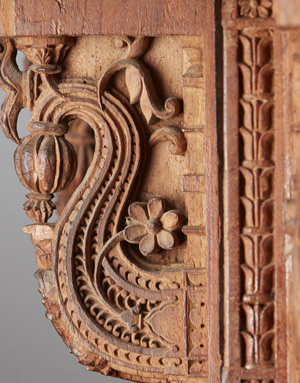In Search of New Markets: Craft Traditions in Nineteenth-Century India
On View:
April 6, 2018 - January 7, 2019
Release Date:
February 16, 2018

Pasadena, CA—The Norton Simon Museum presents In Search of New Markets: Craft Traditions in Nineteenth-Century India, an intimate exhibition that examines the connection—and tension—between Indian artists and their historical practices and the commercial ambitions of colonial administrators in the 1800s. The vast majority of the monumental stone sculptures, metal shrines, votive objects, painted textiles, manuscripts and so-called “miniatures” from South Asia in the Museum’s collection were created for religious or courtly settings, whether in Buddhist, Hindu, Jain or Islamic cultural contexts. By contrast, the seven objects on display for In Search of New Markets—a wooden table, vases, jugs and plates—were created for commercial purposes, and reveal the distinctly modern modes of promotion and distribution that were used to generate demand for them.
Artisans in late 19th-century India faced a contracting market for their work. In response, some reimagined their designs, fusing familiar styles with new shapes and sizes of vessels and furniture that appealed to European buyers. The city Multan, in what is now Pakistan, was long a center of production for glazed ceramics, predominately tiles, which were used to adorn mosques or tombs. As the economy shifted, the number of Indian patrons who could fund such architectural projects waned, and the demand for these tapered. However, the palette and style of floral decoration typical of Multan tile started appearing on new types of vessels. By 1883, a commentator writing for the Journal of Indian Art remarked instead on the wide variety of flowerpots and vases that were for sale there, in forms that “neither the Potter in India nor his ancestors in Persia ever conceived.”
Efforts to produce handmade items of this type at a scale (and price) that could compete with mass-produced goods from abroad were relatively short-lived, peaking at the end of the 19th century. During the 1880s and 1890s, under the auspices of colonial schools of art and independent commercial ventures, Indian artisans produced these vessels, as well as richly carved wooden furniture that incorporated designs from the pierced stone screens, brackets and other architectural features of extant Indian monuments. These designs circulated in pattern books, which were meant to standardize production. Unfortunately, the amount of time and careful labor that even one such piece of furniture required made the cost prohibitive to all but the wealthiest consumers. While the objects featured in this exhibition represent forms of artistic production that proved economically unsustainable in the long run, they remain compelling examples of the ways in which artists and colonial administrators tried to imagine a role for Indian craftsmanship in the everyday lives of buyers worldwide.
In Search of New Markets is organized by Stephanie E. Rozman, assistant curator, and is on view in the Museum’s small rotating exhibitions gallery on the main level from April 6 to September 3, 2018.
Image Credit: India or Pakistan, Table (detail), late 19th century, wood, Norton Simon Art Foundation, from the Estate of Jennifer Jones Simon, M.2010.1.236.S
About the Norton Simon Museum
The Norton Simon Museum is known around the world as one of the most remarkable private art collections ever assembled. Over a 30-year period, industrialist Norton Simon (1907–1993) amassed an astonishing collection of European art from the Renaissance to the 20th century, and a stellar collection of South and Southeast Asian art spanning 2,000 years. Modern and Contemporary Art from Europe and the United States, acquired by the former Pasadena Art Museum, also occupies an important place in the Museum’s collections. The Museum houses more than 12,000 objects, roughly 800 of which are on view in the galleries and gardens.
Location: The Norton Simon Museum is located at 411 W. Colorado Blvd. at Orange Grove Boulevard in Pasadena, Calif., at the intersection of the Foothill (210) and Ventura (134) freeways. For general Museum information, please call (626) 449-6840 or visit nortonsimon.org. Hours: The Museum is open Thursday through Monday, 12 p.m. to 5 p.m. (Friday and Saturday to 7 p.m.). It is closed on Tuesday and Wednesday. Admission: General admission is $20 for adults and $15 for seniors. Members, students with I.D., and patrons age 18 and under are admitted free of charge. The first Friday of the month from 4 to 7 p.m. is free to all. The Museum is wheelchair accessible. Parking: Parking is free but limited, and no reservations are necessary. Public Transportation: Pasadena Transit stops directly in front of the Museum. Please visit http://pasadenatransit.net for schedules. The MTA bus line #180/181 stops in front of the Museum. The Memorial Park Station on the MTA A Line, the closest Metro Rail station to the Museum, is located at 125 E. Holly St. at Arroyo Parkway. Please visit www.metro.net for schedules. Planning your Visit: For up-to-date information on our guidelines and protocols, please visit nortonsimon.org/visit. ![]() @nortonsimon
@nortonsimon![]() @nortonsimon
@nortonsimon![]() /nortonsimonmuseum
/nortonsimonmuseum
Press Contacts
Leslie Denk
(626) 844-6900
[email protected]
Emma Jacobson-Sive
(323) 842-2064
[email protected]
Press Kit
Request Images
High-resolution images from the exhibition may be obtained by emailing [email protected]
Related Links
Visit the exhibition page.
